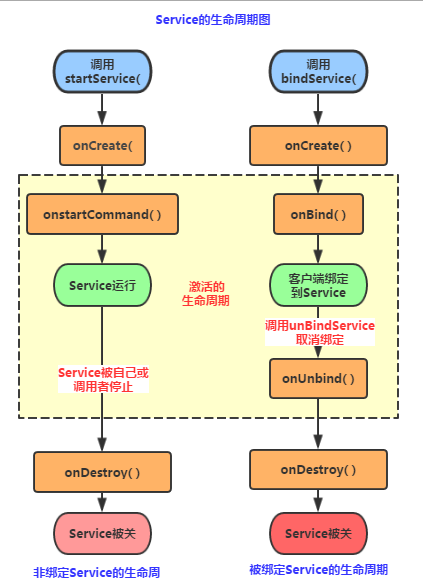![]()
开始
Service 用于在 Android 中执行一些后台任务,实现多任务或者进程间通信
Service 依赖于创建时所在的进程,当进程被杀死后,该进程的所有 Service 均失效
使用 Service 不会自动创建新的线程,若需要去实现一个耗时任务,创建新线程要注意避免 Service 运行在主线程引起的 ANR 问题(应用程序无响应)
创建 Service
创建 Service:继承 Service 类,重写方法
1
2
3
4
5
6
7
8
9
10
11
12
13
14
15
16
17
18
19
20
21
22
| public class TestService extends Service {
@Override
public void onCreate() {
super.onCreate();
}
@Override
public void onDestroy() {
super.onDestroy();
}
@Override
public int onStartCommand(Intent intent, int flags, int startId) {
return super.onStartCommand(intent, flags, startId);
}
@Override
public IBinder onBind(Intent arg0) {
return null;
}
}
|
onCreate:在 Service 被创建时调用,由系统调用onDestroy:在 Service 被销毁时调用,由系统调用onStartCommand:在 Service启动时调用,在该方法中定义任务onBind:返回 IBinder 对象,app 通过 IBinder 对象与 Service 通信
onStartCommand 方法的返回值决定了系统如何处理该 Service
START_STICKY:若系统杀死 Service 后会重新创建,但不能接收 intentSTART_NOT_STICKY:系统杀死 Service 后不会重新创建START_REDELIVER_INTENT:系统杀死 Service 后会重新创建,能够接收 intent
注册 Service
在 AndroidManifest.xml 中注册
1
2
3
4
5
6
| <service android:name=".TestService"
android:enabled="true">
<intent-filter>
<action android:name="com.example.service.TEST_SERVICE"/>
</intent-filter>
</service>
|
启动和停止 Service
相关方法
startService:启动一个 ServicebindService:绑定一个 ServicestopService:停止一个 Service
几种不同的启动方式,Service 内部方法的执行顺序不同
-
调用 startService() 启动
依次调用 onCreate()、onStartCommand(),若多次调用 startService(),则复用创建的 Service 对象,重新调用 onStartCommand()
通过这种方式启动 Service,Service 的生命周期独立于 app,只能调用 stopService() 来停止
-
调用 bindService() 启动
依次调用 onCreate()、onBind(),若多次调用 bindService(),则复用创建的 Service 对象,不会重新调用 onBind(),直接将 IBinder 对象返回给调用端,用于与调用端通信
调用 unbindService() 解除绑定,会调用 Service 的 onUnbind(),当不存在绑定时,调用 onDestroy()
通过这种方式启动 Service,Service 的生命周期与调用端绑定,当调用端销毁,Service 也停止
-
启动后绑定
先调用 startService() 启动服务,再调用 bindService() 绑定
Service 内部触发的方法依次是 onCreate(),onStartCommand(),onBind(),onUnbind(),onRebind()
通过这种方式启动 Service,Service 的生命周期独立,通过 onBind() 返回的 IBinder 与 app 通信,调用 onUnbind 时也不会停止,可以反复绑定
ServiceConnection 对象:bindService() 的参数,可用于监听 app 与 Service 的连接情况
1
2
3
4
5
6
7
8
9
10
11
12
13
14
| public class MyServiceConnection extends ServiceConnection {
@Override
public void onServiceDisconnected(ComponentName name) {
System.out.println("------Service DisConnected-------");
}
@Override
public void onServiceConnected(ComponentName name, IBinder service) {
System.out.println("------Service Connected-------");
binder = (MyBinder) service;
}
}
|
Activity 与 Service 通信
将 Activity 与 Service 进行绑定,使 Activity 可以调用 Service 中的方法
- 在
MyService 类中定义 MyBinder 类,继承 Binder 类,在该类中提供执行的方法
- 在
MyService 类中创建 MyBinder 类的实例,在 onBind() 中返回该对象
- 在
MainActivity 中创建 ServiceConnection 实现类对象,重写方法
- 通过 Intent 将 Activity 与 Service 绑定,调用
bindService(),传入 intent 和 connection 对象和值 Service.BIND_AUTO_CREATE,表示绑定后自动创建 Service,其中会执行 MyService 的 onCreate(),不执行 onStartCommand()
MyService 实现 Service 类
1
2
3
4
5
6
7
8
9
10
11
12
13
14
15
16
17
18
19
20
21
22
23
24
25
26
27
28
29
30
31
32
33
34
35
36
37
38
39
40
41
42
43
44
45
46
47
48
49
50
51
52
53
54
55
56
57
58
59
60
61
62
| public class TestService extends Service {
private final String TAG = "TestService";
private int count;
private boolean quit;
private MyBinder binder = new MyBinder();
public class MyBinder extends Binder {
public int getCount() {
return count;
}
}
@Override
public IBinder onBind(Intent intent) {
Log.i(TAG, "onBind方法被调用!");
return binder;
}
@Override
public void onCreate() {
super.onCreate();
Log.i(TAG, "onCreate方法被调用!");
new Thread() {
public void run() {
while(!quit) {
try {
Thread.sleep(1000);
} catch(InterruptedException e) {
e.printStackTrace();
}
count++;
}
};
}.start();
}
@Override
public boolean onUnbind(Intent intent) {
Log.i(TAG, "onUnbind方法被调用!");
return true;
}
@Override
public void onDestroy() {
super.onDestroy();
this.quit = true;
Log.i(TAG, "onDestroyed方法被调用!");
}
@Override
public void onRebind(Intent intent) {
Log.i(TAG, "onRebind方法被调用!");
super.onRebind(intent);
}
}
|
在 Activity 中使用 Service
1
2
3
4
5
6
7
8
9
10
11
12
13
14
15
16
17
18
19
20
21
22
23
24
25
26
27
28
29
30
31
32
33
34
35
36
37
38
39
40
41
42
43
44
45
46
47
48
| public class MainActivity extends Activity {
MyBinder binder;
private ServiceConnection conn = new ServiceConnection() {
@Override
public void onServiceDisconnected(ComponentName name) {
System.out.println("------Service DisConnected-------");
}
@Override
public void onServiceConnected(ComponentName name, IBinder service) {
System.out.println("------Service Connected-------");
binder = (TestService2.MyBinder) service;
}
};
@Override
protected void onCreate(Bundle savedInstanceState) {
super.onCreate(savedInstanceState);
final Intent intent = new Intent();
intent.setAction("com.example.service.TEST_SERVICE");
btnbind.setOnClickListener(v -> {
bindService(intent, conn, Service.BIND_AUTO_CREATE);
});
btncancel.setOnClickListener(v -> {
unbindService(conn);
});
btnstatus.setOnClickListener(v- > {
int count = binder.getCount()
});
}
}
|
IntentService
使用 Service 进行耗时操作时,容易引发 ANR,这是由于 Service 不会创建线程,它与 app 处于同一个进程中
使用 IntentService 可以解决该问题,IntentService 中存在一个任务队列,将请求的 Intent 放入队列中,在后台线程进行处理
继承 IntentService 类实现相应方法
1
2
3
4
5
6
7
8
9
10
11
12
13
14
15
16
17
18
19
20
21
22
23
24
25
26
27
28
29
30
31
32
33
34
35
36
37
38
39
40
41
42
43
44
45
46
47
48
49
50
51
52
53
54
55
56
57
58
59
60
61
| public class TestService extends IntentService {
private final String TAG = "hehe";
public TestService() {
super("TestService");
}
@Override
protected void onHandleIntent(Intent intent) {
String action = intent.getExtras().getString("param");
if(action.equals("s1")) {
Log.i(TAG,"启动service1");
} else if (action.equals("s2")) {
Log.i(TAG,"启动service2");
} else if (action.equals("s3")) {
Log.i(TAG,"启动service3");
}
try {
Thread.sleep(2000);
} catch(InterruptedException e) {
e.printStackTrace();
}
}
@Override
public IBinder onBind(Intent intent) {
Log.i(TAG,"onBind");
return super.onBind(intent);
}
@Override
public void onCreate() {
Log.i(TAG,"onCreate");
super.onCreate();
}
@Override
public int onStartCommand(Intent intent, int flags, int startId) {
Log.i(TAG,"onStartCommand");
return super.onStartCommand(intent, flags, startId);
}
@Override
public void setIntentRedelivery(boolean enabled) {
super.setIntentRedelivery(enabled);
Log.i(TAG,"setIntentRedelivery");
}
@Override
public void onDestroy() {
Log.i(TAG,"onDestroy");
super.onDestroy();
}
}
|

